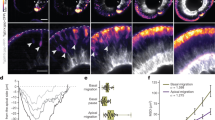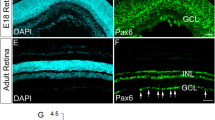Abstract
The mechanisms underlying the precise targeting of tectal layers by ingrowing retinal axons are largely unknown. In zebrafish, individual axons choose one of four retinorecipient layers upon entering the tectum and remain restricted to this layer, despite continual remodeling and shifting of their terminal arbors. In dragnet mutants, by contrast, a large fraction of retinal axons aberrantly trespass between layers or form terminal arbors that span two layers. The dragnet gene, drg, encodes collagen IVα5 (Col4a5), a basement membrane component lining the surface of the tectum. Heparan sulfate proteoglycans (HSPGs) are normally associated with the tectal basement membrane but are dispersed in the dragnet mutant tectum. Zebrafish boxer (extl3) mutants, which are deficient in HSPG synthesis, show laminar targeting defects similar to those in dragnet. Our results show that the collagen IV sheet anchors secreted factors at the surface of the tectum, which serve as guidance cues for retinal axons.
This is a preview of subscription content, access via your institution
Access options
Subscribe to this journal
Receive 12 print issues and online access
$209.00 per year
only $17.42 per issue
Buy this article
- Purchase on Springer Link
- Instant access to full article PDF
Prices may be subject to local taxes which are calculated during checkout








Similar content being viewed by others
References
Sanes, J.R. & Yamagata, M. Formation of lamina-specific synaptic connections. Curr. Opin. Neurobiol. 9, 79–87 (1999).
Nakamura, H. & Sugiyama, S. Polarity and laminar formation of the optic tectum in relation to retinal projection. J. Neurobiol. 59, 48–56 (2004).
Lemke, G. & Reber, M. Retinotectal mapping: new insights from molecular genetics. Annu. Rev. Cell Dev. Biol. 21, 551–580 (2005).
Yamagata, M. & Sanes, J.R. Target-independent diversification and target-specific projection of chemically defined retinal ganglion cell subsets. Development 121, 3763–3776 (1995).
Wohrn, J.C., Puelles, L., Nakagawa, S., Takeichi, M. & Redies, C. Cadherin expression in the retina and retinofugal pathways of the chicken embryo. J. Comp. Neurol. 396, 20–38 (1998).
Yamagata, M., Herman, J.P. & Sanes, J.R. Lamina-specific expression of adhesion molecules in developing chick optic tectum. J. Neurosci. 15, 4556–4571 (1995).
Inoue, A. & Sanes, J.R. Lamina-specific connectivity in the brain: regulation by N-cadherin, neurotrophins, and glycoconjugates. Science 276, 1428–1431 (1997).
Miskevich, F., Zhu, Y., Ranscht, B. & Sanes, J.R. Expression of multiple cadherins and catenins in the chick optic tectum. Mol. Cell. Neurosci. 12, 240–255 (1998).
Liu, Q., Sanborn, K.L., Cobb, N., Raymond, P.A. & Marrs, J.A. R-cadherin expression in the developing and adult zebrafish visual system. J. Comp. Neurol. 410, 303–319 (1999).
Takagi, S. et al. Expression of a cell adhesion molecule, neuropilin, in the developing chick nervous system. Dev. Biol. 170, 207–222 (1995).
Braisted, J.E. et al. Graded and lamina-specific distributions of ligands of EphB receptor tyrosine kinases in the developing retinotectal system. Dev. Biol. 191, 14–28 (1997).
Bartsch, S., Husmann, K., Schachner, M. & Bartsch, U. The extracellular matrix molecule tenascin: expression in the developing chick retinotectal system and substrate properties for retinal ganglion cell neurites in vitro. Eur. J. Neurosci. 7, 907–916 (1995).
Perez, R.G. & Halfter, W. Tenascin in the developing chick visual system: distribution and potential role as a modulator of retinal axon growth. Dev. Biol. 156, 278–292 (1993).
Frost, D.O., Edwards, M.A., Sachs, G.M. & Caviness, V.S., Jr. Retinotectal projection in reeler mutant mice: relationships among axon trajectories, arborization patterns and cytoarchitecture. Brain Res. 393, 109–120 (1986).
Xiao, T., Roeser, T., Staub, W. & Baier, H. A GFP-based genetic screen reveals mutations that disrupt the architecture of the zebrafish retinotectal projection. Development 132, 2955–2967 (2005).
Muto, A. et al. Forward genetic analysis of visual behavior in zebrafish. PLoS Genet. [online] 1, e66 (2005).
Meyer, M.P. & Smith, S.J. Evidence from in vivo imaging that synaptogenesis guides the growth and branching of axonal arbors by two distinct mechanisms. J. Neurosci. 26, 3604–3614 (2006).
Schmidt, J.T., Buzzard, M., Borress, R. & Dhillon, S. MK801 increases retinotectal arbor size in developing zebrafish without affecting kinetics of branch elimination and addition. J. Neurobiol. 42, 303–314 (2000).
Hua, J.Y., Smear, M.C., Baier, H. & Smith, S.J. Regulation of axon growth in vivo by activity-based competition. Nature 434, 1022–1026 (2005).
Easter, S.S. Jr. & Malicki, J.J. The zebrafish eye: developmental and genetic analysis. Results Probl. Cell Differ. 40, 346–370 (2002).
Mould, A.P. et al. Identification of multiple integrin β1 homologs in zebrafish (Danio rerio). BMC Cell Biol. [online] 7, 24 (2006).
Metcalfe, W.K., Myers, P.Z., Trevarrow, B., Bass, M.B. & Kimmel, C.B. Primary neurons that express the L2/HNK-1 carbohydrate during early development in the zebrafish. Development 110, 491–504 (1990).
Sanes, J.R., Schachner, M. & Covault, J. Expression of several adhesive macromolecules (N-CAM, L1, J1, NILE, uvomorulin, laminin, fibronectin, and a heparan sulfate proteoglycan) in embryonic, adult, and denervated adult skeletal muscle. J. Cell Biol. 102, 420–431 (1986).
Kruse, J., Keilhauer, G., Faissner, A., Timpl, R. & Schachner, M. The J1 glycoprotein—a novel nervous system cell adhesion molecule of the L2/HNK-1 family. Nature 316, 146–148 (1985).
Kruse, J. et al. Neural cell adhesion molecules and myelin-associated glycoprotein share a common carbohydrate moiety recognized by monoclonal antibodies L2 and HNK-1. Nature 311, 153–155 (1984).
Poschl, E. et al. Collagen IV is essential for basement membrane stability but dispensable for initiation of its assembly during early development. Development 131, 1619–1628 (2004).
Lee, J.S. & Chien, C.B. When sugars guide axons: insights from heparan sulphate proteoglycan mutants. Nat. Rev. Genet. 5, 923–935 (2004).
Lee, J.-S. et al. Axon sorting in the optic tract requires HSPG synthesis by ext2 (dackel) and extl3 (boxer). Neuron 44, 947–960 (2004).
Yamagata, M., Weiner, J.A., Dulac, C., Roth, K.A. & Sanes, J.R. Labeled lines in the retinotectal system: markers for retinorecipient sublaminae and the retinal ganglion cell subsets that innervate them. Mol. Cell. Neurosci. 33, 296–310 (2006).
Robles, E. & Gomez, T.M. Focal adhesion kinase signaling at sites of integrin-mediated adhesion controls axon pathfinding. Nat. Neurosci. 9, 1274–1283 (2006).
Gaze, R.M., Keating, M.J. & Chung, S.H. The evolution of the retinotectal map during development in Xenopus. Proc. R. Soc. Lond. B 185, 301–330 (1974).
Miner, J.H. & Sanes, J.R. Collagen IV α3, α4, and α5 chains in rodent basal laminae: sequence, distribution, association with laminins, and developmental switches. J. Cell Biol. 127, 879–891 (1994).
Son, Y.J., Patton, B.L. & Sanes, J.R. Induction of presynaptic differentiation in cultured neurons by extracellular matrix components. Eur. J. Neurosci. 11, 3457–3467 (1999).
Fox, M.A. et al. Distinct target-derived signals organize formation, maturation, and maintenance of motor nerve terminals. Cell 129, 179–193 (2007).
White, D.J., Puranen, S., Johnson, M.S. & Heino, J. The collagen receptor subfamily of the integrins. Int. J. Biochem. Cell Biol. 36, 1405–1410 (2004).
Vogel, W., Gish, G.D., Alves, F. & Pawson, T. The discoidin domain receptor tyrosine kinases are activated by collagen. Mol. Cell 1, 13–23 (1997).
Venstrom, K. & Reichardt, L. Beta 8 integrins mediate interactions of chick sensory neurons with laminin-1, collagen IV, and fibronectin. Mol. Biol. Cell 6, 419–431 (1995).
Halfter, W. & Schurer, B. Disruption of the pial basal lamina during early avian embryonic development inhibits histogenesis and axonal pathfinding in the optic tectum. J. Comp. Neurol. 397, 105–117 (1998).
Halfter, W., Dong, S., Balasubramani, M. & Bier, M.E. Temporary disruption of the retinal basal lamina and its effect on retinal histogenesis. Dev. Biol. 238, 79–96 (2001).
Halfter, W., Dong, S., Yip, Y.P., Willem, M. & Mayer, U. A critical function of the pial basement membrane in cortical histogenesis. J. Neurosci. 22, 6029–6040 (2002).
Hu, H. Cell-surface heparan sulfate is involved in the repulsive guidance activities of Slit2 protein. Nat. Neurosci. 4, 695–701 (2001).
Van Vactor, D., Wall, D.P. & Johnson, K.G. Heparan sulfate proteoglycans and the emergence of neuronal connectivity. Curr. Opin. Neurobiol. 16, 40–51 (2006).
Stier, H. & Schlosshauer, B. Different cell surface areas of polarized radial glia having opposite effects on axonal outgrowth. Eur. J. Neurosci. 10, 1000–1010 (1998).
Barker, D.F. et al. Identification of mutations in the COL4A5 collagen gene in Alport syndrome. Science 248, 1224–1227 (1990).
Hudson, B.G., Tryggvason, K., Sundaramoorthy, M. & Neilson, E.G. Alport's syndrome, Goodpasture's syndrome, and type IV collagen. N. Engl. J. Med. 348, 2543–2556 (2003).
Kawakami, H. et al. Chronic nephritis, sensorineural deafness, growth and developmental retardation, hyperkinesis, and cleft soft palate in a 5-year-old boy. A new combination? Nephron 56, 214–217 (1990).
Shields, G.W., Pataki, C. & DeLisi, L.E. A family with Alport syndrome and psychosis. Schizophr. Res. 3, 235–239 (1990).
Sener, R.N. Hereditary nephritis (Alport syndrome): MR imaging findings in the brain. Comput. Med. Imaging Graph. 22, 71–72 (1998).
Scott, E.K. et al. Targeting neural circuitry in zebrafish using GAL4 enhancer trapping. Nat. Methods. 4, 323–326 (2007).
Acknowledgements
We thank L.F. Reichardt, S. Pleasure, N. Shah, W. Staub and L. Nevin for their advice and comments on this manuscript. M. Berberoglu contributed data to the axon counts in BGUG fish. C.-B. Chien (University of Utah) kindly provided boxer mutants and 10E4 antibody. This work was supported by the US National Institutes of Health (R01-EY013855 and R01-EY012406 to H.B. and a neuroscience postdoctoral training grant fellowship to T.X.) H.B. was further supported by a David and Lucile Packard Fellowship and an Esther and Joseph Klingenstein Fellowship.
Author information
Authors and Affiliations
Contributions
T.X. carried out all the experiments and prepared the figures. H.B. conceived the project and wrote the paper together with T.X.
Corresponding author
Supplementary information
Supplementary Text and Figures
Supplementary Figures 1–5, Supplementary Table 1, Supplementary Methods (PDF 4546 kb)
Rights and permissions
About this article
Cite this article
Xiao, T., Baier, H. Lamina-specific axonal projections in the zebrafish tectum require the type IV collagen Dragnet. Nat Neurosci 10, 1529–1537 (2007). https://doi.org/10.1038/nn2002
Received:
Accepted:
Published:
Issue Date:
DOI: https://doi.org/10.1038/nn2002
This article is cited by
-
A brain-specific angiogenic mechanism enabled by tip cell specialization
Nature (2024)
-
The embryonic patterning gene Dbx1 governs the survival of the auditory midbrain via Tcf7l2-Ap2δ transcriptional cascade
Cell Death & Differentiation (2023)
-
Pax6 modulates intra-retinal axon guidance and fasciculation of retinal ganglion cells during retinogenesis
Scientific Reports (2020)
-
Sequence analysis and spatiotemporal developmental distribution of the Cat-1-type transporter slc7a1a in zebrafish (Danio rerio)
Fish Physiology and Biochemistry (2020)
-
A transgenic zebrafish model for in vivo long-term imaging of retinotectal synaptogenesis
Scientific Reports (2018)



